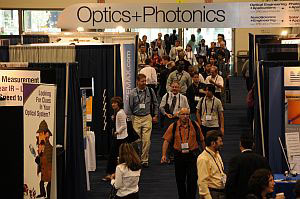SPIE Optics+Photonics 2008
SAN DIEGO, Aug. 14, 2008 – This year’s SPIE Optics+Photonics symposium was the largest meeting of the annual symposium thus far. The show, which ends today, enjoyed sessions on nano and solar technologies, strategies for communication, and solid-state lighting and OLED innovations.
Attendees included experts in optical fabricators, lens design, software, optical fiber, optical test and measurement equipment, and optical materials, substrates and detectors.
The five-day event was divided into four technical conferences on the topics of nanoscience and engineering, solar energy, photonic devices and optical engineering. This year, 279 exhibitors filled the San Diego Convention Center to enjoy technologies and applications that provide essential knowledge for leading edge advances. 
Optics+Photonics 2008 symposium at the San Diego Convention Center. Photo courtesy of SPIE.
A well-attended plenary session by Dave Irvine-Halliday of the University of Calgary, Canada, focused on improving the quality of life for billions of people by the use of sustainably powered solid state lighting and OLEDs.
Touching on the current challenges of OLEDs, Mark E. Thompson of the University of Southern California explained in his session that rather than using RGB sources side-by-side or stacking transparent RGB devises, his work focused on the chemistry of mixing emitters in a single devise. According to Thompson, by doing this there are many different ways to achieve acceptable electrophosporescence and that materials development is critical for the advancement of new lighting devices.
The University of Mexico’s Sanjay Krishna discussed the concept of an infrared retina for remote sensing applications. He explained that a non-uniform distribution of photosensitive pixels with a highly concentrated active region could be composed of quantum dots placed in InGaAs wells, also known as “quantum dots in a well” detectors, or composed of nBn detectors based on InAs/GaSb type-II strain layer superlattices.
Another hot topic was communication from within the scientific community to the public. The session stressed the need for the public to understand what scientists are doing so that good personal and public policy decisions can be made in an increasingly technologically driven world. Science writer and Women in Optics speaker, Margaret Wertheim, urged her audience to strategize the promotion of public understanding of science by way of also appreciating science’s “beauty, wonder and power.”
Perhaps one of the largest plenary sessions was a series of talks about nano and solar technologies. Joseph Zyss of Ecole Normale Superieure de Cachan, France, spoke of the strong foundation of nanoscience and engineering built by early researchers studying molecular physics and chemistry. According to Zyss, this work allowed new developments in multi-photon techniques that enable a more complete understanding of the chemistry and physics of molecules and their interaction dynamics.
Rajesh R. Naik of the Air Force Research Laboratory discussed the use of biological material as nanostructures and their applications in biomedical and sensing arenas, while Harry Atwater of the California Institute of Technology spoke of recent developments in solar cells and how nano structures and the field of plasmonics may enhance the collection and conversion efficiency of solar cells of the future.
There was also a tribute conference honoring the contributions of Larry Dalton, professor at the University of Washington, culminated with Dalton giving a historical perspective on his field, organic electro-optical materials, which he said are “absolutely critical to our next great technology revolution.”
Dalton explained that organic electro-optical materials will play a key role in maintaining economic and technological leadership. “We’re going to have to integrate photonics, microfluidics and biosensor capability on chips, and this is really going to create a revolution in our lives,” he said.
About 100 students from around the globe attended a leadership workshop to learn how to create and sustain an SPIE Student Chapter. They exchanged ideas about how to motivate colleagues at their respective universities to participate in outreach and professional development activities. They also heard from Sanjay Krishna, associate professor of Electrical and Computer Engineering at the University of New Mexico (USA), and SPIE president Kevin Harding, Optical Metrology Leader at GE Global Research in New York (USA).
For more information, visit: www.spie.org